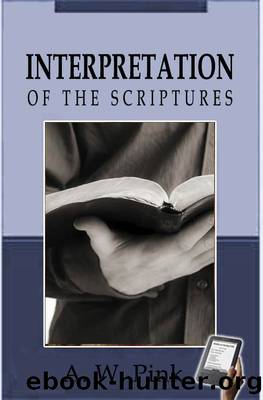Interpretation of the Scriptures by A.W. Pink

Author:A.W. Pink
Language: eng
Format: mobi
Tags: Theology
Publisher: Monergism Books
Published: 2011-12-05T06:00:00+00:00
Chapter 12
17. Exposition of the parables. This is another branch of our subject to which at least one whole chapter should be devoted, but the danger of overtaxing the patience of some of our readers renders it inadvisable. Because of the great simplicity of their nature and language, it is commonly supposed that the parables are more easily understood than any other form of scriptural instruction, when the fact is that probably more erroneous teaching has been given out through misapprehending the force of some of their details than is the case with anything else in the Word. Great care needs to be taken with them: especially is it important to ascertain and then keep in mind the scope or leading design of each one. But instead of so doing, only too often they are approached solely for the purpose of finding apparent support for some particular doctrine or idea which the preacher desires to prove. And in consequence, not a little in them has been wrested from its original purport, and made to signify what is flatly contradicted by other passages. Here, too, the Analogy of Faith must be held steadily in view, and our interpretation of each parable made to square therewith.
The children’s definition that "a parable is an earthly story with a heavenly meaning" expresses the general idea. It is a form of teaching whereby spiritual things are represented under sensible images. Parables are virtually word pictures, bearing somewhat the same relation to the instruction of those to whom they are addressed as do the pictorial illustrations used in books to elucidate for the reader the printed page. From the relation to the truth presented or lesson enforced can be gathered certain important but simple and obvious principles, which need to be borne in mind in the study of our Lord’s parables. First, the parable, as an illustrative picture, can only present its subject partially. No picture can give every aspect or exhibit every side of its object, any more than an architect’s "ground plan" of a building shows its second and third stories, far less depict it as when completed—though it might suggest something of them. So a parable sketches for us only certain aspects of the subject. Hence we find them in groups: all in a group representing the same subject, but each one setting forth a distinct feature of the same—as in those of Matthew 13, dealing with the "mysteries of the kingdom of heaven." Hence, too, those of Luke 15 show us not only grace receiving sinners; but seeking, finding, clothing, feasting them.
Second, parables are subordinate to direct teaching; being designed not for proof, but for illustration of a doctrine or duty. It is alway to be deplored when professing Christians are guilty of setting one part of the Scriptures against another, but when a parable is used to nullify some plain doctrine or commandment of God, absurdity is added to irreverence. Hence to appeal to Matthew 18:23-25, in proof that the God
Download
This site does not store any files on its server. We only index and link to content provided by other sites. Please contact the content providers to delete copyright contents if any and email us, we'll remove relevant links or contents immediately.
The 5 Love Languages: The Secret to Love That Lasts by Gary Chapman(8494)
The Space Between by Michelle L. Teichman(6087)
Assassin’s Fate by Robin Hobb(5236)
Wiseguy by Nicholas Pileggi(4586)
Everything Happens for a Reason by Kate Bowler(4067)
Gerald's Game by Stephen King(3918)
A Simplified Life by Emily Ley(3567)
The Power of Positive Thinking by Norman Vincent Peale(3447)
Pillow Thoughts by Courtney Peppernell(3395)
Resisting Happiness by Matthew Kelly(2886)
Girl, Wash Your Face by Rachel Hollis(2821)
Being Aware of Being Aware by Rupert Spira(2706)
Name Book, The: Over 10,000 Names--Their Meanings, Origins, and Spiritual Significance by Astoria Dorothy(2490)
Real Sex by Lauren F. Winner(2474)
More Language of Letting Go: 366 New Daily Meditations by Melody Beattie(2442)
The Holy Spirit by Billy Graham(2416)
Fast Facts on Defending Your Faith by John Ankerberg & John Weldon(2388)
Victory over the Darkness by Neil T. Anderson(2386)
The Secret Power of Speaking God's Word by Joyce Meyer(2253)
